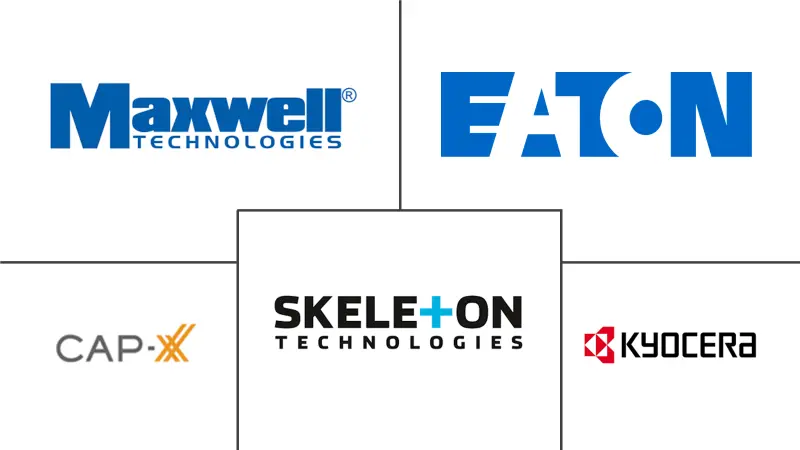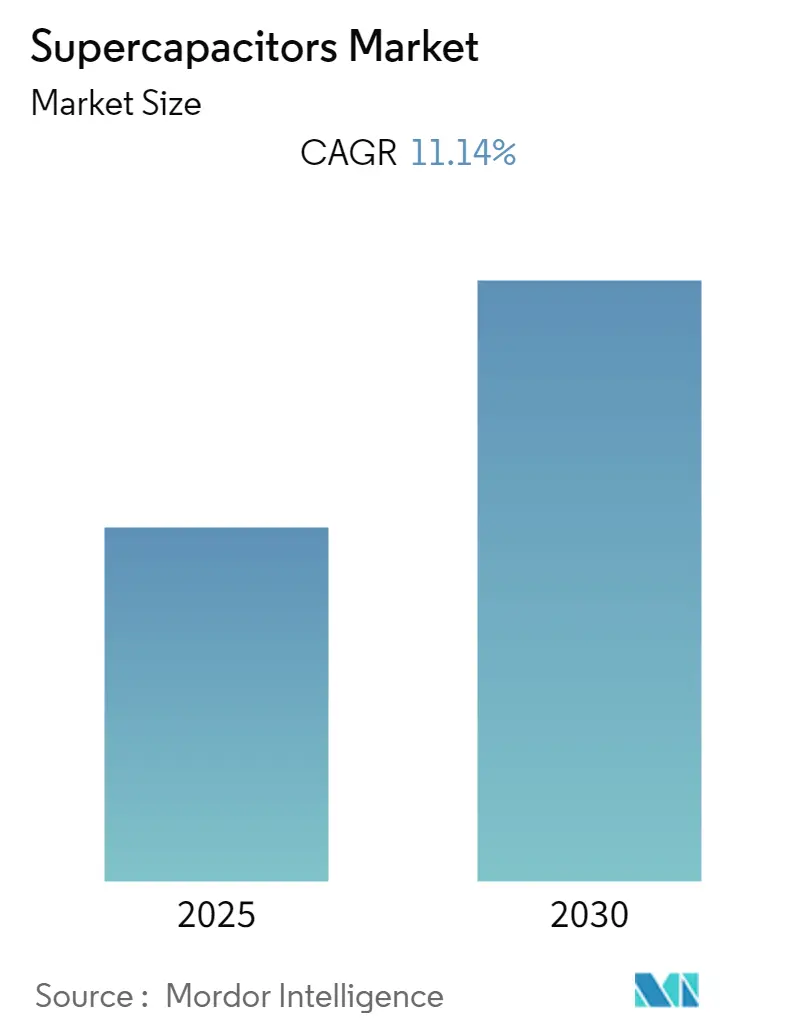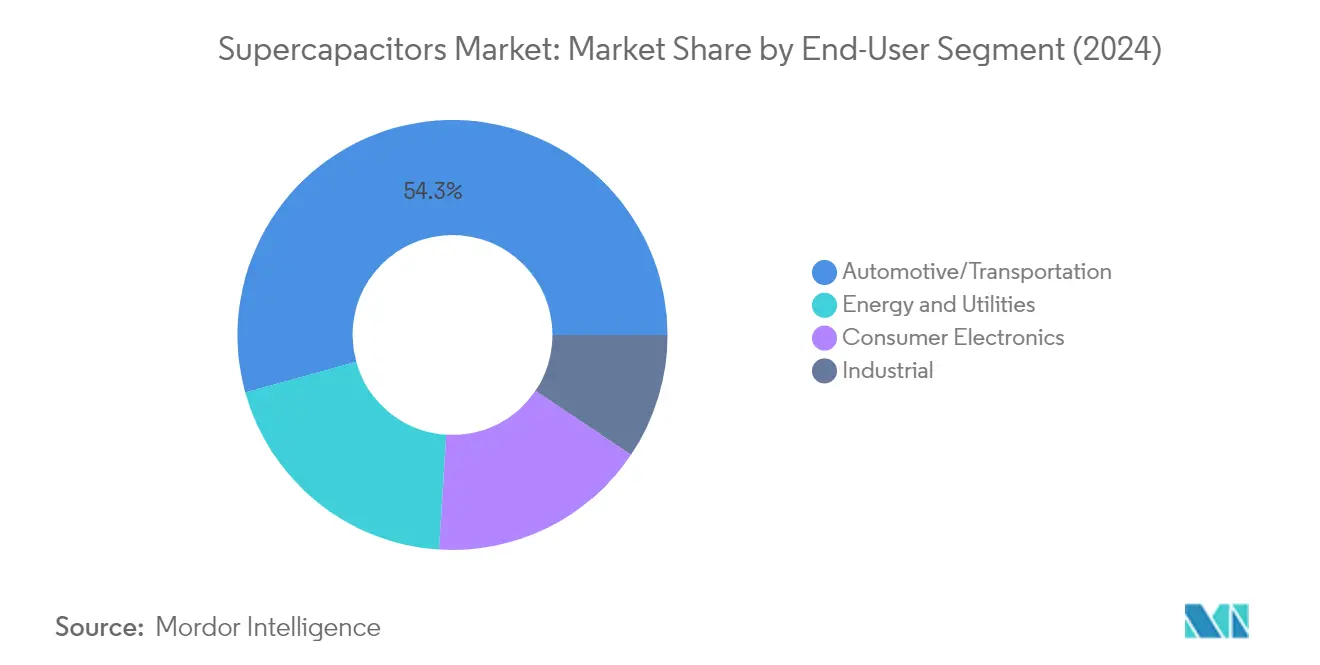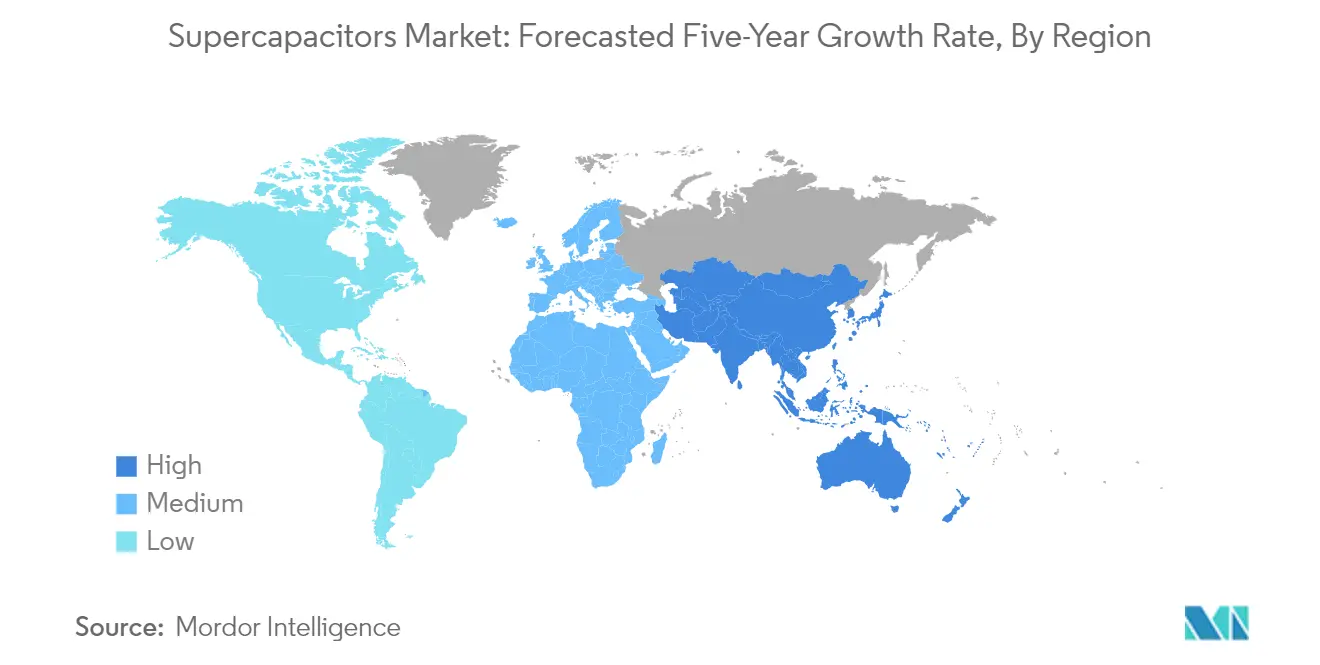Supercapacitors Market Size
Supercapacitors Market Analysis
The Supercapacitors Market is expected to register a CAGR of 11.14% during the forecast period.
The supercapacitor industry is experiencing significant transformation driven by technological advancements and research initiatives focused on improving efficiency and sustainability. Researchers from Imperial College London and University College London have recently developed more sustainable and energy-dense electrode materials for supercapacitors, marking a crucial breakthrough in the field. This development is particularly significant as it addresses both performance and environmental concerns simultaneously. The industry is witnessing increased collaboration between academic institutions and commercial entities to accelerate innovation and bring new solutions to market. These partnerships are focusing on developing more affordable solutions while reducing dependency on critical components and lowering carbon-based electrode production costs.
The automotive sector continues to be a major catalyst for supercapacitor market expansion, with electric vehicle adoption reaching unprecedented levels. According to industry data, global electric vehicle sales reached 10.6 million units in 2022, representing a 57% growth compared to the previous year, with approximately 27 million EVs operating worldwide by year-end. Supercapacitors are increasingly being integrated into various automotive applications, from start-stop systems to regenerative braking. Major automotive manufacturers are exploring innovative applications, such as Maxwell's development of supercapacitor-connected lead-acid batteries that can withstand temperatures up to 3000 degrees Fahrenheit, with over 600,000 units already deployed in hybrid start-stop applications.
The power sector is undergoing a significant digital transformation, incorporating advanced technologies across its infrastructure. This transformation encompasses smart meters, digital substations, and smart EV charging infrastructure, alongside sophisticated software solutions including artificial intelligence and blockchain technology. The Indian government's recent announcement of a Revamped Distribution Sector Scheme, with an investment exceeding USD 40 billion, exemplifies the scale of digital infrastructure development occurring globally. These initiatives are creating new opportunities for supercapacitor applications in grid stabilization and energy storage solutions.
The integration of supercapacitors in communication systems and space technology represents another significant market trend. The Indian Space Research Organization's development of variable-capacity supercapacitors at its Vikram Sarabhai Space Center demonstrates the technology's expanding applications in advanced sectors. In the consumer electronics segment, supercapacitors are finding new applications in portable devices, addressing the growing demand for stable power supply in applications such as GPS devices, portable media players, and laptops. Texas Instruments' recent introduction of a bidirectional buck/boost converter with ultra-low quiescent current represents the industry's focus on improving energy efficiency and extending battery life in consumer applications.
Supercapacitors Market Trends
Rising Demand for Renewable Energy Solutions
The increasing focus on renewable energy sources has become a significant driver for supercapacitor adoption, particularly in wind power and solar energy applications. Supercapacitors serve as crucial components in renewable energy systems, offering superior efficiency with charge/discharge capabilities and wide temperature range tolerance, making them ideal for wind turbines and solar installations. For instance, globally, more than 14,000 installed wind turbines currently utilize supercapacitors for pitch control systems, demonstrating the technology's widespread acceptance in the renewable energy sector. The integration of supercapacitors in wind power systems effectively addresses high current fluctuations, with their ability to store energy during strong winds and discharge during speed fluctuations, enabling smoother output power for more efficient grid systems.
The growing investment in smart grid infrastructure and energy storage solutions further accelerates supercapacitor adoption in the renewable energy sector. For example, after mobilizing investments of USD 300 million through its National Smart Grid Mission, India announced a Revamped Distribution Sector Scheme with a cost exceeding USD 40 billion, highlighting the significant opportunities for supercapacitor implementation in grid modernization. In solar applications, supercapacitors are increasingly being utilized in both online and offline modes, with conservative estimates suggesting a demand of around 416,000 units for solar generation applications. Additionally, various government-supported programs, including solar home systems and solar lanterns, are expected to generate additional demand for approximately 10 million supercapacitor units.
Increasing Production of Supercapacitor-based Vehicles Owing to Environmental Concerns
The automotive industry's shift toward electric and hybrid vehicles has emerged as a crucial driver for the supercapacitors for automotive market growth, driven by stringent environmental regulations and the need for more efficient energy storage solutions. Supercapacitors offer significant advantages in automotive applications, including quick charging capabilities, temperature stability, and enhanced performance in start-stop systems. The technology has proven particularly effective in hybrid start-stop applications, with over 600,000 supercapacitors sold for this purpose, demonstrating strong market acceptance. The integration of supercapacitors in vehicles has shown to reduce fuel consumption and carbon emissions by up to 32% through kinetic energy recovery systems (KERS), making them increasingly attractive for automotive manufacturers focused on meeting environmental standards.
The automotive industry's commitment to electrification is further evidenced by significant technological developments and partnerships. For instance, Lamborghini collaborated with the Massachusetts Institute of Technology's chemistry department to develop innovative synthetic materials for next-generation supercapacitors, specifically targeting automotive applications. This trend is supported by growing electric vehicle adoption, with global EV sales reaching 10.6 million units in 2022, representing a 57% increase from the previous year. The market has also witnessed innovative applications, such as Maxwell's development of a supercapacitor-connected lead-acid battery system that addresses high-energy demands in vehicles while maintaining optimal performance at temperatures up to 3000 degrees Fahrenheit, demonstrating the technology's versatility and reliability in automotive applications.
Segment Analysis: By End User
Automotive/Transportation Segment in Supercapacitors Market
The automotive and transportation segment dominates the global supercapacitors market, accounting for approximately 54% of the total market share in 2024. This segment's prominence is driven by the increasing adoption of supercapacitors in various transportation applications, including electric buses, trains, trams, and hybrid vehicles. The segment is also experiencing the fastest growth rate in the market, as automotive manufacturers emphasize reducing dependency on the oil sector and governing bodies impose stringent environmental regulations. Supercapacitors are effectively being used to improve the efficiency of hybrid electric vehicles in various ways, particularly in applications such as regenerative braking, start-stop systems, and power assistance. The integration of supercapacitors in electric buses has been particularly successful, with many cities worldwide deploying supercapacitor-powered public transportation systems that can be charged rapidly at stations.
Energy and Utilities Segment in Supercapacitor Technology Market
The energy and utilities segment represents a significant growth opportunity in the supercapacitor technology market, driven by the increasing focus on renewable energy sources and smart grid applications. This segment's growth is supported by the rising demand for efficient energy storage solutions in grid applications, microgrids, and uninterruptible power supply systems. The integration of ultracapacitors in wind turbine pitch control systems has become increasingly common, with more than 14,000 installed turbines using ultracapacitors globally. The segment's expansion is further fueled by various government initiatives and investments in smart grid infrastructure, particularly in regions focusing on modernizing their power distribution networks and increasing renewable energy integration.
Remaining Segments in Supercapacitor Market
The consumer electronics and industrial segments complete the supercapacitor market landscape, each contributing significantly to the overall market dynamics. The consumer electronics segment is witnessing increased adoption in smartphones, tablets, and wearable devices, where supercapacitors provide rapid charging capabilities and improved power management. In the industrial sector, supercapacitors are gaining traction in applications such as automated guided vehicles (AGVs), material handling equipment, and industrial machinery, where high-power density and quick charging capabilities are essential. These segments are benefiting from ongoing technological advancements in supercapacitor design and manufacturing, leading to improved performance and expanded application possibilities.
Supercapacitors Market Geography Segment Analysis
Supercapacitors Market in Europe
Europe stands as a cornerstone of the global supercapacitor market, commanding approximately 27% of the global market share in 2024. The region's dominance is driven by its robust automotive industry, particularly in Germany, where leading manufacturers are integrating smart technologies and focusing on electric vehicle innovations. The presence of key market players like Skeleton Technologies, which has established significant production capabilities in Saxony, Germany, further strengthens Europe's position. The region's commitment to sustainable transportation is evident in its extensive implementation of supercapacitors in rail systems, with companies like Medcom, Skoda Transportation, and CAF Power and Automation leading the charge. European nations are also at the forefront of research and development, with initiatives like the European Commission's Graphene Flagship pushing the boundaries of energy storage technology. The region's aggressive smart grid initiatives and commitment to renewable energy integration have created substantial opportunities for supercapacitor applications in grid stabilization and energy storage solutions.
Supercapacitors Market in China
China's supercapacitors market demonstrates exceptional dynamism, projected to grow at approximately 15% annually from 2024 to 2029. The country's market is characterized by its comprehensive integration of supercapacitor technology across various sectors, particularly in public transportation and renewable energy applications. China's leadership in electric bus deployment, with cities like Shenzhen operating extensive fleets of supercapacitor-powered vehicles, showcases its commitment to sustainable urban transportation. The nation's robust manufacturing ecosystem and significant investments in research and development have fostered innovations in supercapacitor technology, particularly in areas like graphene-based solutions. The government's emphasis on new energy vehicles and smart grid development has created a conducive environment for market expansion. Chinese manufacturers have been particularly successful in developing cost-effective solutions while maintaining high performance standards, enabling broader adoption across industrial applications.
Supercapacitors Market in United States
The United States maintains a strong position in the global supercapacitor market, driven by its advanced automotive sector and increasing focus on renewable energy integration. The country's market is characterized by significant research and development activities, with numerous universities and private institutions working on next-generation supercapacitor technologies. The adoption of supercapacitors in the United States is particularly notable in the consumer electronics sector, where demand for high-performance energy storage solutions continues to grow. The country's robust industrial infrastructure and emphasis on energy efficiency have created numerous applications for supercapacitors in smart grid systems and renewable energy storage. The presence of major technology companies and automotive manufacturers has fostered innovation in supercapacitor applications, particularly in electric vehicles and grid stabilization systems. The market also benefits from strong government support for clean energy initiatives and sustainable transportation solutions.
Supercapacitors Market in Japan
Japan's supercapacitors market is distinguished by its strong focus on technological innovation and integration with the country's advanced manufacturing sector. The nation's automotive industry, led by major manufacturers like Toyota and Mazda, has been instrumental in driving supercapacitor adoption through their electric vehicle initiatives. Japan's market is characterized by its emphasis on high-quality, reliable energy storage solutions, particularly in industrial applications and consumer electronics. The country's commitment to smart grid technology and energy efficiency has created numerous opportunities for supercapacitor applications in utility-scale energy storage. Japanese companies have been particularly successful in developing specialized applications for supercapacitors in areas such as regenerative braking systems and power quality improvement. The market benefits from strong collaboration between industry and research institutions, leading to continuous improvements in supercapacitor technology and applications. The Japan supercapacitor market is poised for growth as these innovations continue to evolve.
Supercapacitors Market in Other Countries
The supercapacitors market extends beyond the major players to encompass diverse regions, including South Korea, India, and various European nations. These markets are characterized by their unique approaches to supercapacitor adoption, often driven by specific industrial needs and environmental regulations. Countries in the Asia-Pacific region, particularly South Korea, have shown strong potential in consumer electronics applications, while European nations beyond the major markets have focused on renewable energy integration. Latin American countries are increasingly adopting supercapacitor technology in their public transportation systems, while Middle Eastern nations are exploring applications in solar energy storage. The diversity of applications and varying levels of technological adoption across these markets contribute to the global market's dynamism and provide opportunities for market expansion and technological innovation. Notably, supercapacitor manufacturers in India are emerging as key players in this evolving landscape.
Supercapacitors Industry Overview
Top Companies in Supercapacitors Market
The supercapacitor market is characterized by continuous product innovation focused on improving energy density, reducing form factors, and enhancing temperature tolerance ranges. Supercapacitor companies are investing heavily in research and development to develop next-generation materials like graphene and advanced electrode technologies. Operational agility is demonstrated through automated production lines and flexible manufacturing capabilities that allow customization for specific applications. Strategic partnerships, particularly with automotive and renewable energy companies, have become increasingly common as manufacturers seek to expand their market presence. Geographic expansion strategies are primarily focused on the Asia-Pacific region, with companies establishing manufacturing facilities and distribution networks to capitalize on the growing demand from electric vehicles and consumer electronics sectors. The industry also shows a strong trend toward vertical integration, with supercapacitor manufacturers developing in-house capabilities for raw material processing and system integration.
Market Structure Shows Dynamic Competitive Environment
The supercapacitors market exhibits a mix of global conglomerates and specialized manufacturers, with companies like Eaton Corporation, Kyocera, and Panasonic representing the multinational presence, while specialized players like Skeleton Technologies and Cap-XX focus exclusively on supercapacitor technology. The market structure is relatively fragmented, with regional players, particularly in China and Japan, holding significant market share in their respective territories. The competitive landscape has been shaped by notable mergers and acquisitions, such as Tesla's acquisition and subsequent sale of Maxwell Technologies to UCAP Power, demonstrating the dynamic nature of market consolidation efforts.
The industry is witnessing increased collaboration between established manufacturers and technology startups, particularly in developing advanced materials and manufacturing processes. Market participants are actively pursuing strategic alliances with automotive manufacturers and renewable energy companies to secure long-term contracts and establish themselves in high-growth application segments. The competitive environment is further characterized by significant investments in manufacturing capabilities, with companies establishing automated production facilities to achieve economies of scale and maintain quality standards.
Innovation and Market Adaptation Drive Success
For incumbent companies to maintain and expand their market share, focus on technological innovation and cost optimization remains crucial. Leading players are investing in research and development to improve product performance while simultaneously working to reduce manufacturing costs through automation and process optimization. The ability to offer customized solutions for specific applications, particularly in emerging sectors like electric vehicles and renewable energy storage, has become a key differentiator. Companies are also strengthening their intellectual property portfolios and developing comprehensive service offerings to create additional value propositions for customers.
New entrants and challenger companies can gain ground by focusing on niche applications and developing specialized products for specific industry segments. Success factors include establishing strong partnerships with end-users during product development phases, maintaining flexibility in manufacturing processes to accommodate custom requirements, and developing innovative solutions for emerging applications. The market shows moderate substitution risk from competing energy storage technologies, making it essential for companies to clearly demonstrate the unique advantages of supercapacitors in specific applications. Regulatory support for clean energy technologies and electric vehicles continues to create favorable conditions for market expansion, though companies must remain adaptable to evolving standards and requirements. Additionally, the Cap-XX share forecast is influenced by these strategic adaptations and market dynamics.
Supercapacitors Market Leaders
-
Eaton Corporation PLC
-
Skeleton Technologies Inc.
-
Cap-XX Limited
-
Maxwell Technologies Inc. (Tesla Inc.)
-
Kyocera Corporation
- *Disclaimer: Major Players sorted in no particular order
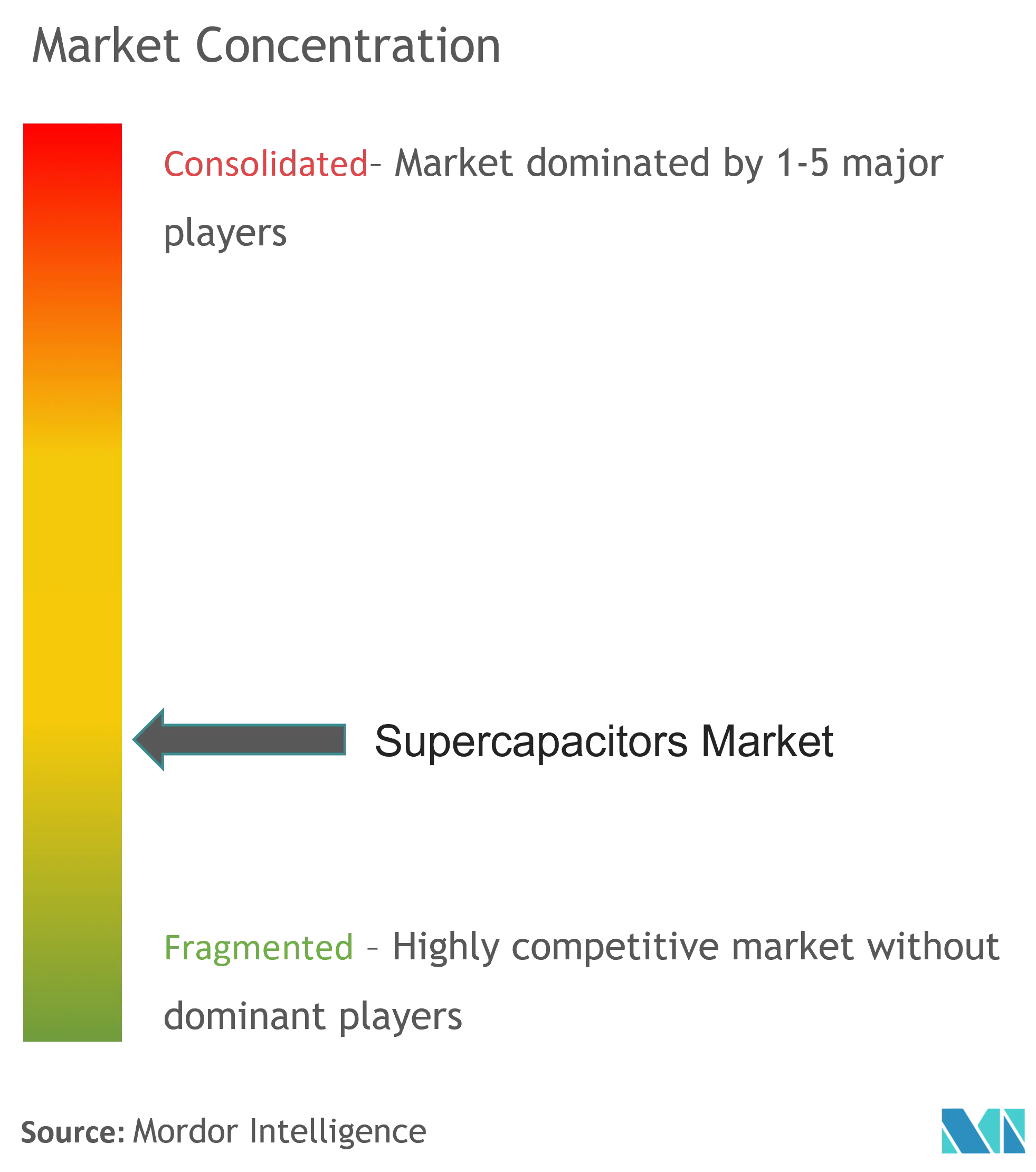
Supercapacitors Market News
- September 2022 - Godi India announced the development of supercapacitors to improve battery life in EVs. The company is the first to manufacture 3000F (farads) high-power supercapacitors at its Hyderabad facility. The company is also planning to commission 200 kWh of the supercapacitors production facility to cater to various local requirements and export markets.
- July 2022 - Skeleton Technologies and Siemens announced entering a technology partner to develop, plan, and implement a fully automated, digitalized manufacturing plant to produce supercapacitors in Germany. The collaboration aims to digitize Skeleton's entire value chain, from supercapacitor cell design to production and services, and scale up the next-generation supercapacitors production.
Supercapacitors Industry Segmentation
Supercapacitors (or ultracapacitors) utilize high surface area electrode materials and thin electrolytic dielectrics to achieve high capacitance values. They have more capacitance than conventional capacitors and store more energy. Supercapacitors can be of various types, such as double-layer, pseudo, and hybrid capacitors. They can be used for different end-user industries, such as consumer electronics, energy and utilities, industrial, and automotive.
The Supercapacitors Market is segmented by end-user (consumer electronics, energy, and utilities (grid applications, wind, and others), industrial (automotive/transportation (bus and truck, rail and tram, 48 V mild hybrid car, micro hybrids, and other cars, heavy vehicle), and geography (United States, Europe, China, Japan, Korea and rest of Asia, and rest of the world). The market sizes and forecasts are provided in value (USD) for all the above segments.
| By End-User | Consumer Electronics | ||
| Energy and Utilities | Grid Applications (Including Micro Grid and UPS) | ||
| Wind and Others | |||
| Industrial | |||
| Automotive/Transportation | Bus and Truck | ||
| Rail and Tram | |||
| 48V Mild Hybrid Car | |||
| Micro Hybrids and Other Cars | |||
| Heavy Vehicles | |||
| By Geography | United States | ||
| Europe | |||
| China | |||
| Japan | |||
| Korea and Rest of Asia | |||
| Rest of the World | |||
Supercapacitors Market Research FAQs
What is the current Supercapacitors Market size?
The Supercapacitors Market is projected to register a CAGR of 11.14% during the forecast period (2025-2030)
Who are the key players in Supercapacitors Market?
Eaton Corporation PLC, Skeleton Technologies Inc., Cap-XX Limited, Maxwell Technologies Inc. (Tesla Inc.) and Kyocera Corporation are the major companies operating in the Supercapacitors Market.
Which is the fastest growing region in Supercapacitors Market?
Asia-Pacific is estimated to grow at the highest CAGR over the forecast period (2025-2030).
Which region has the biggest share in Supercapacitors Market?
In 2025, the Europe accounts for the largest market share in Supercapacitors Market.
What years does this Supercapacitors Market cover?
The report covers the Supercapacitors Market historical market size for years: 2019, 2020, 2021, 2022, 2023 and 2024. The report also forecasts the Supercapacitors Market size for years: 2025, 2026, 2027, 2028, 2029 and 2030.
Our Best Selling Reports
Supercapacitors Market Research
Mordor Intelligence provides a comprehensive analysis of the supercapacitor market. We leverage our extensive expertise in tracking electrochemical capacitors and energy storage technologies. Our detailed research covers both ultracapacitors and super capacitor technologies. It offers an in-depth analysis of various applications, including consumer electronics, automotive, and industrial sectors. The report examines key players, including prominent manufacturers of supercapacitors in India and global supercapacitor companies. It also analyzes crucial market dynamics and technological innovations.
Stakeholders benefit from our thorough market size projections and market forecast analyses. These are delivered in an easily accessible report PDF format available for download. The research provides valuable insights into ultracapacitor market size trends, emerging technologies, and growth opportunities across different regions. Our analysis includes a detailed evaluation of supercapacitor electrode material developments and energy storage system applications. Additionally, it offers a competitive landscape assessment of leading ultracapacitors companies, enabling informed decision-making for industry participants and investors.

